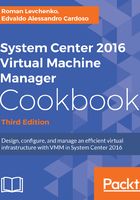
New storage features in VMM 2016
When we discussed possible architectures for management clusters, I referred to a new feature in Windows Server 2016 and VMM 2016, Storage Spaces Direct (S2D). S2D uses industry-standard servers with local storage which could be direct-attached enclosures or internal disks. S2D provides similar shared storage pools across cluster nodes by leveraging Cluster Shared Volume, Storage Spaces, Failover Clustering and SMB3 protocol for file access (SOFS). Hyper-converged and converged solutions can now be based on software-defined storage running on Windows Server 2016. So, you have a choice: to buy external enterprise SAN or to use S2D. If your goal is a software-defined datacenter, the answer to all questions is very clear - S2D and SDN implementation. The main competitor to S2D is a well-known VMware Virtual SAN (vSAN) that was first released in vSphere 5.5 and is still present in the newest vSphere 6.6. S2D, just like a vSAN, has special licensing requirements.

Furthermore, improved Storage QoS in VMM 2016 provides a way to centrally monitor and manage storage performance for virtual machines residing on S2D or another device. Storage QoS was first introduced in 2012 R2 version. You could set maximum and minimum IOPS thresholds for virtual hard disks (excluding shared virtual hard disks). It worked well on standalone Hyper-V hosts, but if you have a cluster with a lot of virtual machines or even tenants, it could be complicated to achieve the right QoS for all cluster resources. The feature automatically improves storage resource fairness between multiple virtual machines using the same file server cluster. In other words, QoS for storage will be distributed between a group of virtual machines and virtual hard disks:

Another feature available only in Windows Server 2016 Datacenter edition is Storage Replica (SR). Previously, we needed to find third-party solutions for SAN-to-SAN replication. And building stretched clusters required a huge amount of money. Windows Server 2016 and VMM 2016 can help to significantly reduce costs and enhance unification in such scenarios. SR is the main component of multi-site clusters or disaster recovery solutions supporting both asynchronous and synchronous replication between any storage devices, including Storage Spaces Direct. Also, you are not required to have identical devices on both sides. However, at the time of writing, only synchronous replication is supported in VMM fabric, and deployment is limited to PowerShell.